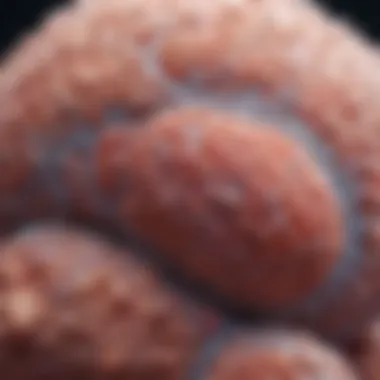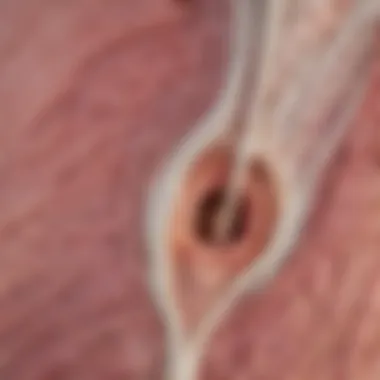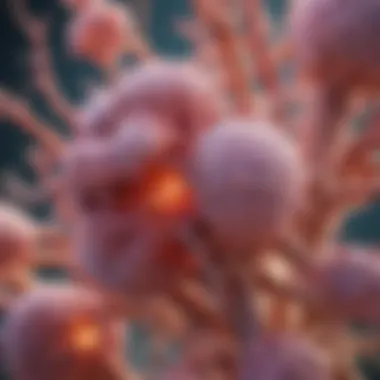Fibromyxoid Stroma in Basal Cell Carcinoma: Analysis


Intro
Fibromyxoid stroma in basal cell carcinoma represents a complex intersection of histopathological features and biological behavior. Understanding this unique stroma is crucial for anyone delving into skin cancer research or treatment. The stroma, the supportive tissue surrounding cancer cells, is not just a passive entity; it adapts and interacts profoundly with tumors, influencing everything from growth to immune response. To unearth the specifics of how fibromyxoid stroma plays a role in basal cell carcinoma is to open a door to better diagnosis and innovative treatment approaches. This examination does not merely serve academic purposes; it directly speaks to improving patient outcomes and understanding the dynamics at play in cancer biology.
Research Background
Overview of the Scientific Problem Addressed
Basal cell carcinoma, one of the most prevalent forms of skin cancer, is frequently dismissed as merely a nuisance due to its relatively low potential for metastasis. However, the presence of fibromyxoid stroma often complicates this neat categorization. This stroma affects tumor behavior, with potential implications for growth rates, invasiveness, and recurrence. Despite how common basal cell carcinoma is, there remains a striking lack of comprehensive research focused on how its fibromyxoid stroma influences clinical outcomes.
Historical Context and Previous Studies
Historically, the fibromyxoid stroma was often viewed through the lens of basic morphology. Early studies primarily focused on classification and crude histopathological features. Over the years, researchers like Timothy J. Eden and colleagues offered insights into the variance in stromal composition, laying the groundwork for understanding the stroma's role beyond mere structural support. Recent advancements have begun to elucidate the molecular dialogues occurring between stromal and neoplastic cells, indicating that fibromyxoid stroma may actually contribute to tumor progression rather than simply serving as an innocent bystander.
As we dive deeper into the nuances of these findings, it becomes clear that recognizing the multifaceted nature of fibromyxoid stroma can offer pathways not just for diagnosis but for innovative therapeutic avenues. The challenge lies in embracing this complexity in both research methodologies and clinical practice.
Overview of Basal Cell Carcinoma
Basal cell carcinoma (BCC) is the most common form of skin cancer, often arising in areas of the skin exposed to the sun. This section lays the groundwork for understanding the significance of BCC, especially when examining the role of fibromyxoid stroma.
The relevance of discussing BCC in detail cannot be overstated. BCC presents unique challenges in both diagnosis and treatment due to its propensity for local invasion and, in rare cases, metastasis. Through this exploration, we provide a comprehensive snapshot of the disease, which serves as a crucial background for analyzing its interaction with the fibromyxoid stroma.
Definition and Classification
Basal cell carcinoma originates from the basal cells located in the lower epidermis. The classification of BCC is based on histological features, which can range from superficial BCC to more aggressive forms such as nodular and infiltrative types. This classification helps determine treatment strategies and guides clinical decision-making. By distinguishing between these subtypes, physicians can better predict behavior and customize management plans tailored to patients' specific cases.
Epidemiology of Basal Cell Carcinoma
Prevalence and Incidence Rates
The incidence of basal cell carcinoma is increasing globally, particularly in regions with high sun exposure. According to various studies, BCC accounts for over 80% of non-melanoma skin cancers. One major aspect of prevalence is its notable occurrence in Caucasian populations, particularly those with fair skin. The importance of understanding these rates lies in the prevention strategies that can be devised to combat this common malignant skin condition.
Risk Factors
Several risk factors contribute to the likelihood of developing basal cell carcinoma. These include prolonged exposure to ultraviolet (UV) radiation, a history of sunburns, and certain genetic predispositions. Additionally, age plays a vital role, with older individuals facing a higher risk. Awareness of these risk factors not only aids in early identification but also highlights the need for public education regarding sun protection measures. Knowing these elements empowers both individuals and healthcare professionals to take proactive steps against BCC.
Clinical Presentation and Diagnosis
Common Clinical Features
Basal cell carcinoma typically manifests as a persistent, non-healing sore, a shiny bump, or a waxy lesion on previously sun-exposed skin. Such features can sometimes lead to misdiagnosis if not recognized promptly. The distinct appearances of BCC types, whether they are nodular or superficial, hold particular importance in guiding initial assessments and management approaches for patients.
Diagnostic Techniques


Accurate diagnosis of BCC relies on both clinical evaluation and histological examination. Techniques such as dermoscopy and biopsy are instrumental in differentiating BCC from other skin lesions. Dermoscopy enhances visualization of the lesion, helping clinicians make more informed decisions about the nature of the growth. Skipping this crucial step can lead to inappropriate treatment, further complicating patient outcomes. As such, rapid and accurate diagnostic techniques are essential in the fight against this common skin cancer.
Understanding Fibromyxoid Stroma
Fibromyxoid stroma plays a critical role in shaping the dynamics of basal cell carcinoma, influencing both its progression and response to treatment. This section aims to illuminate the nuanced characteristics and biological functions of this type of stroma, ultimately contributing to a more thorough understanding of its implications in the clinical setting.
Histological Characteristics
Components of Fibromyxoid Stroma
The fibromyxoid stroma is primarily composed of a diverse array of cell types, including fibroblasts, myofibroblasts, and extracellular matrix proteins. Notably, the extracellular matrix (ECM) makes a significant contribution to the stroma’s unique properties. Essential proteins within the ECM, such as fibrillin and fibronectin, provide structural support, while also facilitating cellular interactions.
A fundamental characteristic of these components is their ability to influence tumor microenvironments. This interplay often enhances tumor development, making it a prime focus for researchers. One interesting detail about fibroblasts is their responsiveness to signals within their surroundings. They can change their behavior based on the tumor's status, either promoting or inhibiting cancer growth. This adaptability is a double-edged sword, presenting both opportunities and challenges for effective treatment strategies.
Stroma in Tumor Microenvironment
Focusing on the tumor microenvironment, the fibromyxoid stroma serves as a foundation where cellular interactions unfold. This stroma harbors a variety of signaling molecules that orchestrate a communication network between tumor cells and stromal components. One critical characteristic is its dynamic nature, which allows the stroma to modify its composition in response to changes in tumor behavior.
This adaptability can either facilitate tumor advancement or hinder it, depending on the context. A unique aspect lies in its role in mediating immune responses, which can potentially influence how the tumor is recognized by the immune system. In some instances, this can lead to immune evasion by the tumor, complicating therapeutic efforts.
Biological Functions
Role in Tissue Repair
The fibromyxoid stroma is integral to the healing process, acting as a scaffold for cellular migration and function during tissue repair. A defining feature is its ability to secrete various growth factors that recruit cells to the site of injury. For instance, transforming growth factor-beta (TGF-β) is a key player in promoting fibroblast activity and collagen synthesis, essential for structural integrity during the repair process. This characteristic makes fibromyxoid stroma a vital element in regeneration post-injury, yet it can paradoxically contribute to excessive fibrosis, which could lead to further complications.
Contribution to Tumorigenesis
Conversely, this stroma also has significant implications for tumorigenesis. It can create a permissive environment that supports tumor growth through the suppression of anti-tumor immune responses. One notable characteristic of the stromal interaction with tumor cells is the release of cytokines and chemokines, fostering tumor progression. Unique here is the idea that the same components that repair tissue can also inadvertently assist in its ruin through fostering a pro-tumorigenic niche. This duality needs careful consideration when devising treatment plans, as targeting the stroma could yield varying results depending on the stage and context of the cancer.
In summary, understanding fibromyxoid stroma is key to deciphering its multifaceted roles in basal cell carcinoma. As research in this area continues to unfold, the hope is to find innovative approaches that can exploit its characteristics for better diagnostic and therapeutic strategies.
The Interaction Between Fibromyxoid Stroma and Basal Cell Carcinoma
Understanding the interaction between fibromyxoid stroma and basal cell carcinoma is crucial. This relationship can significantly influence tumor biology and patient outcomes. Several factors contribute to this interplay, including the role of the stroma in tumor support and its involvement in cancer progression. Thus, exploring these dynamics offers insights that could potentially lead to better diagnostic and therapeutic strategies.
Stromal Influence on Tumor Behavior
Stromal-Induced Tumor Growth
The concept of stromal-induced tumor growth revolves around how the surrounding connective tissue influences the cancer cells. Fibromyxoid stroma, characterized by its unique matrix composition, has a propensity to provide a nurturing environment for tumor cells. It can facilitate the proliferation of basal cell carcinoma through paracrine signaling mechanisms.
A notable characteristic of stromal-induced tumor growth is its ability to modify the local microenvironment, thus fostering a supportive niche for cancer cells. This leads to an accelerated growth rate and enhanced viability of the tumor. The unique feature here lies in how certain components of the stroma, like fibroblasts, secrete growth factors that encourage tumor cell survival and division. However, while this interaction may seem beneficial for tumor development, it also complicates treatment by making the tumor more resilient to therapies.


Impacts on Invasion and Metastasis
When we talk about the impacts on invasion and metastasis, we’re looking at the role of fibromyxoid stroma in how basal cell carcinoma spreads. The stroma not only supports tumor growth but also contributes to how cancer cells invade surrounding tissues. This can lead to more aggressive forms of cancer and complicates treatment options significantly.
The key characteristic here is that fibromyxoid stroma alters the physical and biochemical landscape of the tumor microenvironment, enabling cancer cells to breach local boundaries. This is particularly relevant as the unique composition of stroma can affect the invasiveness of tumor cells; for example, increased levels of certain matrix metalloproteinases (MMPs) can degrade the extracellular matrix, promoting invasion. Such interactions underscore the need to understand the stroma better, as they present both a challenge and potential opportunities for targeted therapies.
Molecular Pathways Involved
Signaling Pathways
Diving into the signaling pathways, it’s essential to acknowledge their pivotal role in the interaction between fibromyxoid stroma and basal cell carcinoma. These pathways can communicate changes from the tumor microenvironment to the tumor cells themselves, driving fundamental changes in behavior.
One notable aspect is how these pathways dictate cellular responses. For instance, the activation of pathways like Hedgehog or Wnt can result from stromal signals, leading to enhanced proliferative and migratory capabilities of cancer cells. This relationship is particularly useful to highlight in this article, as these signaling cascades are potential points for therapeutic intervention. Identifying the unique features of these interactions can help in developing impactful treatment strategies.
Interactions Between Stromal Cells and Tumor Cells
Interactions between stromal cells and tumor cells represent a significant aspect of cancer biology. These relationships can dictate tumor progression and therapeutic resistance, making them a focal point for this analysis. For example, cancer-associated fibroblasts (CAFs) in the stroma can alter tumor growth patterns, impacting how the cancer responds to conventional treatments.
A critical feature of this interaction is the bidirectionality it exhibits; while stromal cells can influence tumor fate, tumor cells often reprogram stromal cells, creating a feedback loop that enhances malignancy. This dynamic is beneficial for this article, as it showcases the complexity of these interactions, revealing potential targets for therapeutic strategies that could disrupt these cycles and improve patient outcomes.
"The interplay between stroma and tumor cells is not merely a bystander phenomenon; it’s an active dialogue that shapes cancer evolution and therapeutic response."
Clinical Implications of Fibromyxoid Stroma in Basal Cell Carcinoma
The fibromyxoid stroma presents considerable implications when it comes to understanding basal cell carcinoma. Its intricate relationship with tumor biology makes it pivotal in the realms of diagnosis and treatment. By dissecting the vital aspects of this stromal tissue, we gain insights that are not merely academic but can guide clinical practices and improve patient care. Specifically, the two key areas of focus are prognostic significance and potential therapeutic targets, both of which illuminate how fibromyxoid stroma can influence patient outcomes.
Prognostic Significance
Effective prognosis in basal cell carcinoma hinges on various factors, one of which is the character of the stroma surrounding the tumor cells. It can be easy to overlook this component, but the condition of the stroma often tells us a lot about the tumor’s behavior and potential trajectory.
Stromal Composition and Tumor Outcomes
The composition of the fibromyxoid stroma plays a crucial role in determining tumor outcomes. Some studies have observed that a dense and fibrotic stroma often correlates with a higher likelihood of local recurrence. This is often because the dense fibers can provide a more supportive environment for the cancer cells, allowing them to proliferate more effectively.
- Key Characteristic: The presence of specialized extracellular matrix proteins can promote tumor growth.
- Benefit: By identifying these characteristics, clinicians might better estimate patient prognosis and tailor follow-up plans accordingly.
- Unique Feature: This role of stroma can be seen as a double-edged sword; while it supports tumor growth, it can also limit metastasis, making its study all the more intricate.
Correlation with Treatment Responses
Treatment responses in basal cell carcinoma can also be significantly affected by the stroma. Understanding this relationship can provide critical insights into how patients might respond to different therapeutic approaches.
- Key Characteristic: Variations in stromal composition can influence the effectiveness of specific treatments, particularly targeted therapies.
- Benefit: This understanding helps in customizing treatment plans for individual patients, leading to better overall outcomes.
- Unique Feature: Notably, some treatments may provoke alterations in stroma over time, which can subsequently modify tumor behavior and treatment responses.
Potential Therapeutic Targets


Emerging trends in therapy point towards targeting the fibromyxoid stroma as a potentially effective tactic against basal cell carcinoma.
Targeting Stromal Components
Targeting the components of fibromyxoid stroma presents a unique avenue for therapeutic intervention. For instance, modulating the stroma's cytokine composition provides a novel method for influencing cancer progression.
- Key Characteristic: This approach can disrupt the supportive environment that tumors rely on for sustained growth.
- Benefit: If successful, therapies aimed at stroma could offer a new line of defense, enabling clinicians to tackle the disease from multiple fronts.
- Unique Feature: The downside lies in the potential for unintended consequences; disrupting stromal functions might provoke adverse effects in normal tissue surrounding the tumor area.
Innovative Treatment Approaches
Innovation doesn’t stop at identifying targets; it extends to the methods used in treatment. Developments in nanotechnology, for example, are beginning to show promise in selectively attacking the stroma without harming surrounding healthy tissues.
- Key Characteristic: New techniques could allow for localized treatment with fewer side effects, which is crucial for maintaining the quality of life in affected patients.
- Benefit: Greater precision in treatment could significantly enhance patient comfort and outcomes.
- Unique Feature: However, as with all new therapies, careful monitoring and research are necessary to ensure safety and efficacy.
Understanding the clinical implications of fibromyxoid stroma not only enhances our understanding of basal cell carcinoma but also lays the foundation for future research and therapeutic innovations. By knowing what to look for in the stroma, healthcare providers can make better-informed decisions that could improve patient longevity and quality of life.
Research Directions and Future Perspectives
The landscape of research into fibromyxoid stroma and its role in basal cell carcinoma is expanding at a rapid pace. Understanding the intricacies and implications of this stroma is vital—not only for academia but also for clinical practices. This section will shed light on emerging technologies and collaborative frameworks that are aimed at elucidating the complex interplay between fibromyxoid stroma and tumor biology, ultimately paving the way for novel diagnostic and therapeutic strategies.
Emerging Technologies in Stroma Research
Advancements in Imaging Techniques
Innovative imaging techniques have come a long way in recent years, delivering deeper insights into stromal components and their interactions within the tumor microenvironment. One standout among these advancements is multiphoton microscopy. This technique allows for detailed imaging of thick samples, revealing structural and functional dynamics of fibromyxoid stroma in situ. It is particularly valuable in preserving tissue architecture while affording real-time observation.
The key feature of this approach is its ability to generate high-resolution images that are vital for understanding the spatial distribution of stromal cells. By visualizing how these cells communicate with tumor cells, researchers gain a more nuanced understanding of cancer progression. Though the initial setup can be costly and requires specialized skills, the long-term benefits—including enhanced clarity in structural analyses—make it a compelling choice for this research.
Genomic and Proteomic Analyses
In terms of unraveling molecular mechanisms, genomic and proteomic analyses have emerged as cornerstones in tumor biology studies. Such technologies allow scientists to dissect the vast array of proteins and genetic materials present in the fibromyxoid stroma. Techniques like mass spectrometry and RNA sequencing provide quantitative data that are crucial for identifying biomarkers related to tumor behavior.
What makes genomic and proteomic analyses pivotal is their holistic approach; they examine the stroma at multiple levels—molecules, proteins, and their interactions. This all-encompassing perspective can highlight alterations that might contribute to tumor progression. However, challenges include data complexity and the need for sophisticated bioinformatics tools to interpret the results adequately.
Need for Multidisciplinary Approaches
Integrating Clinical, Biological, and Computational Studies
The need for multidisciplinary approaches is becoming increasingly evident in this domain. Integrating clinical, biological, and computational studies offers a well-rounded view of fibromyxoid stroma in basal cell carcinoma. This triad allows for a fusion of therapeutic insights, biological mechanisms, and data analysis.
A crucial aspect of this integration is the ability to adapt clinical findings into research questions that can be explored in the laboratory. This backward-and-forward relationship ensures that the research remains relevant and grounded in actual patient experiences, fostering advancements that truly impact outcomes.
Yet, this method also faces hurdles, such as the necessity for effective communication between different fields and the challenges posed by variable terminologies and methodologies across disciplines.
Collaborative Research Initiatives
Turning to collaborative research initiatives, one of the most prominent characteristics is the pooling of resources and expertise across various sectors. Such partnerships may involve universities, hospitals, and biotechnology companies, enhancing the depth and breadth of investigation into fibromyxoid stroma.
These collaborative efforts can lead to groundbreaking findings that might go unnoticed in siloed research frameworks. Specifically, sharing specimens and data can yield insights that are otherwise limited due to sample sizes. However, one must tread carefully, as managing diverse teams can sometimes complicate the research process and hinder timely results.
In summary, as research on fibromyxoid stroma continues to evolve, embracing new technologies and collaborative frameworks will be paramount. By fostering interdisciplinary dialogue and harnessing advanced methodologies, this field can explore the multifaceted roles of stroma in basal cell carcinoma, ultimately leading to improved patient management and outcomes.







